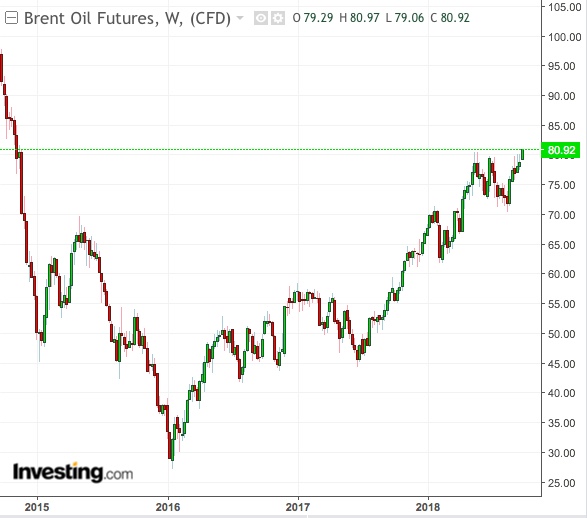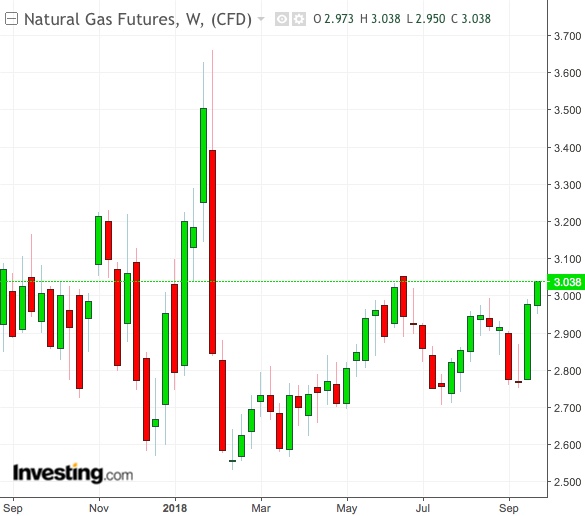Brent crude’s spike above $80 a barrel and natural gas’s rally beyond the key $3 level are prompting Wall Street bankers and traders to ask whether the new age of high energy prices could be arriving faster than expected. For more than three years, the surfeit of oil from US shale fields has made a distant memory of the $100-per barrel prices seen before the financial crisis and amid the Libyan supply squeeze of 2010-2013.
Similarly, abundant gas supplies have ensured that the fuel’s double digit pricing, seen during the summer of 2008, never returned. But this year so far, crude’s conflicting supply-demand factors—which pitted the economic meltdown in oil producer Venezuela against the US-China trade war—have prevented any rally from getting out of hand.
Uncertainties about winter heating demand have also kept gas prices from steaming over in the past two months, despite a surge in power demand as air conditioners ran day and night in many US cities amid one of the hottest summers in years.
Clock Ticking Toward Iran Sanctions
Now, however, crude looks poised to rewrite any highs seen in 2018 as the clock ticks toward Donald Trump’s November 3 vow to turn Iranian crude exports into zero through sanctions. Simultaneously, worries about unusually low gas stockpiles ahead of the winter heating season are making nervous traders seek premiums for the fuel that are far from their usual levels of this time of year.
“Underinvestment in the energy space has put us behind the demand curve and global production is going to struggle to keep up,” said Phil Flynn of Chicago’s Price Futures Group, a self-confessed oil bull and one of the most closely-watched forecasters of trends in crude.

While Brent has been mostly strong this year, ending lower only in February and July, trading in the global oil benchmark has been quite volatile, with swings of nearly $10 a barrel at times. But with the market persistently testing $80 in each of the past three weeks and settling at four-year peaks above that mark on Monday, some of Wall Street’s top banks and trading houses believe three-digit prices are just months away.
Speculation Of $90 and $100 Oil From Here
J.P. Morgan, which has forecast Brent to average $85 over the next six months, says "a spike to $90 per barrel is likely" in the coming months due to US sanctions on Iranian oil exports, which could wipe out as much as 1.5 million barrels from the 2.6 million bpd shipped by the Islamic state daily.
Trump, while demanding full compliance by all of the United States’ trading partners in acting against Tehran, has also asked the Organization of the Petroleum Exporting Countries (OPEC) to produce more to compensate the loss of Iranian supply and prevent any untoward rally in oil. OPEC, led by Saudi Arabia, has refused to accommodate the US President, who has also threatened to sell crude from the US Strategic Petroleum Reserve (SPR) to douse the rally.
Commodity traders Trafigura and Mercuria said Brent could rise to $90 per barrel by Christmas and pass $100 in early 2019, Reuters reported on Monday. Mercuria, particularly, warned that as much as 2 million bpd of Iranian output could be knocked out.
Bank of America Merrill Lynch said it was lifting its 2019 Brent forecast to $80 from $75 previously. For US West Texas Intermediate crude, it had a more modest hike to $71 from $69 previously.
John Kilduff, founding partner at energy hedge fund Again Capital, was quoted as saying on CNBC that he expected Brent’s next target to be $83-$85 and “that should engender follow-through buying" which could become a sell-fulfilling prophecy for the new high-oil-price-era.
Demand Destruction Likely, Some Warn
Not all are excited by the prospect of $100 oil though. Scott Shelton, broker and analyst for ICAP in Durham, North Carolina, says many appear to have forgotten the demand destruction sparked just years ago by such prices.
“It pains me a bit to see the banks start talking about $95 to $100 oil as history tells you that anything that is 'consensus' loses money generally,” Shelton wrote on Monday.
He added that data from the US Commodity Futures Trading Commission on trader commitments on crude oil “shows that the market is not nearly as long as it was previously when (it) made new highs in June.”
Dominick Chirichella, director of risk management and trading at the Energy Management in New York, was similarly cautious. He said:
“There are still some variables out there that could offset another strong move to the upside… release of oil from the SPR, OPEC members increasing production quietly and even a resolution between Iran and the US."
No Bets On Endurance Of Gas Rally

As for natural gas, late warmth in September and a near decade low in pre-winter heating stocks were helping keep the market above the $3 per million British thermal units (mmBtu) targeted by bulls.
While almost no one is betting that gas prices will recapture the summer highs of 2008, when it got to beyond $13 per mmBtu, few can say with certainty how long the current rally will last.
“Expectations for a significantly below-average storage injection are still propping up prices early this week,” Daniel Myers, gas analyst at Gelber & Associates in Houston, wrote on Monday.
